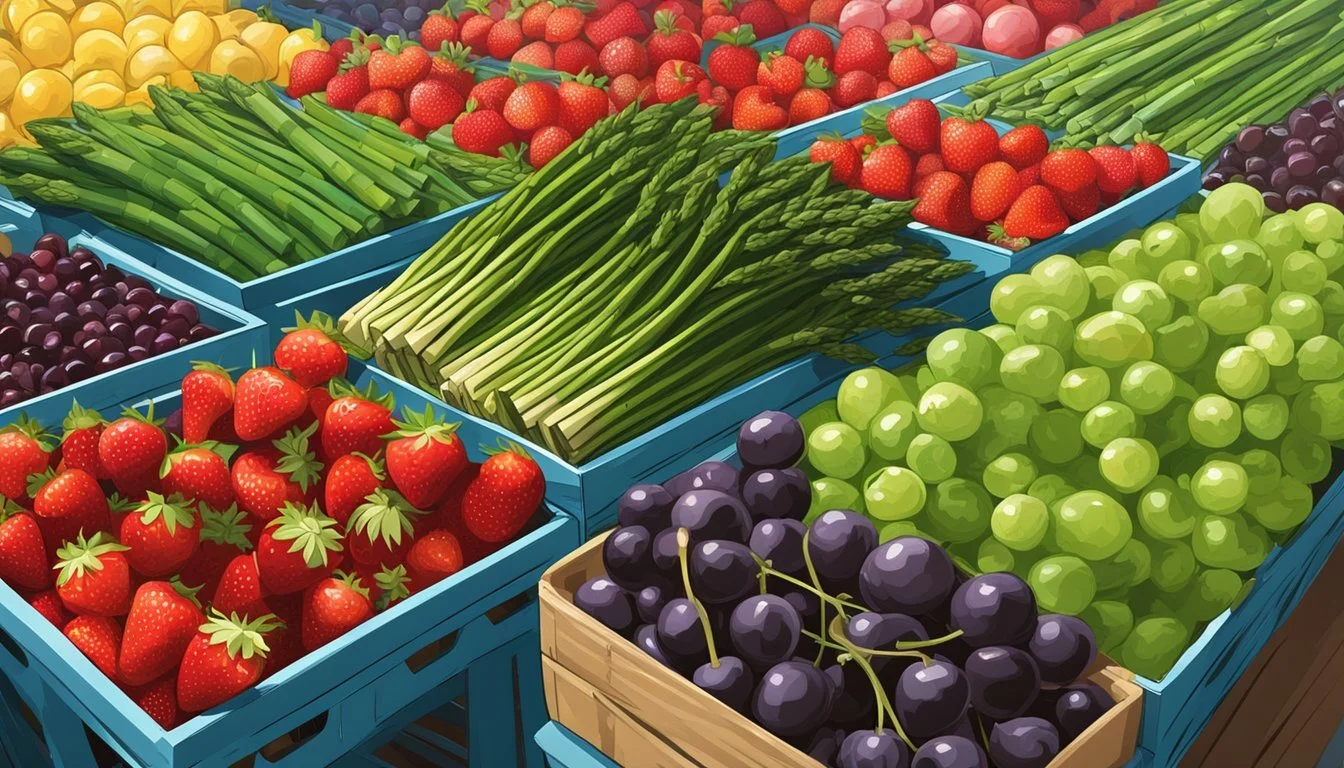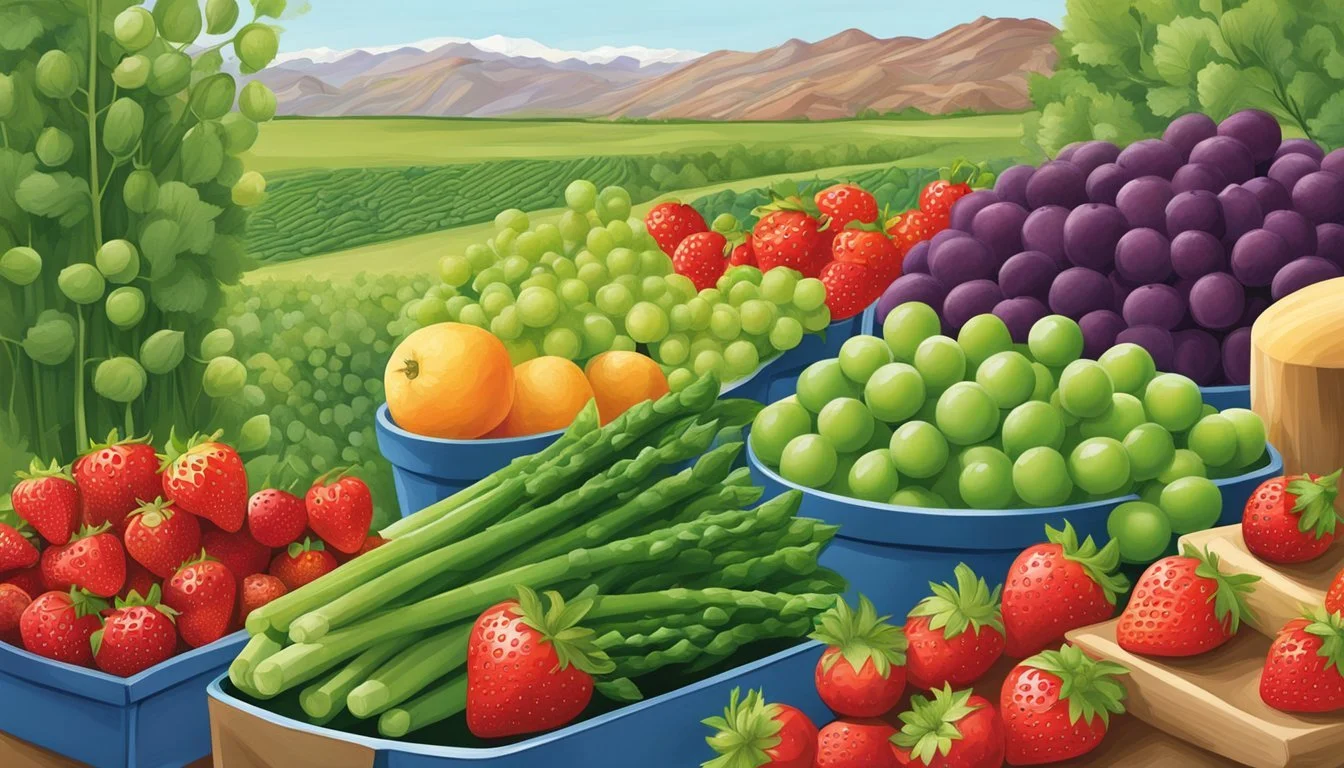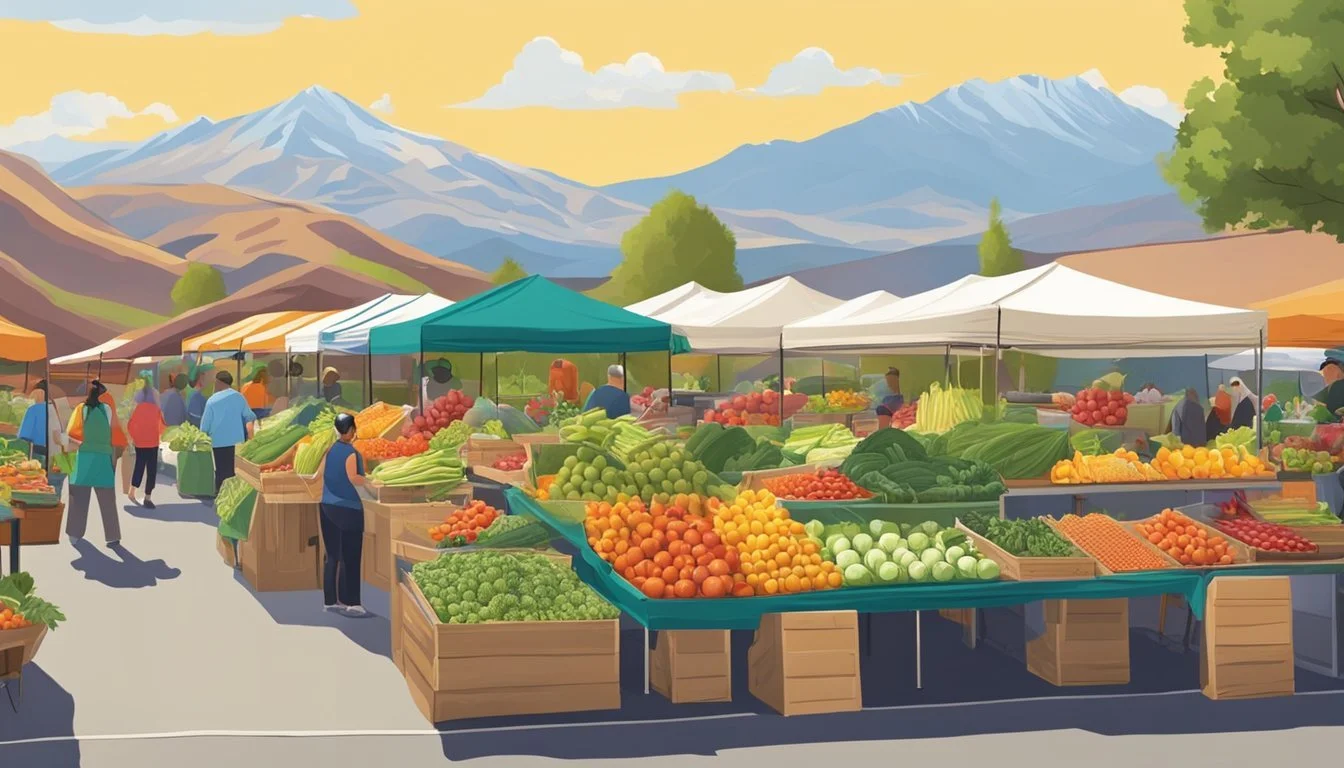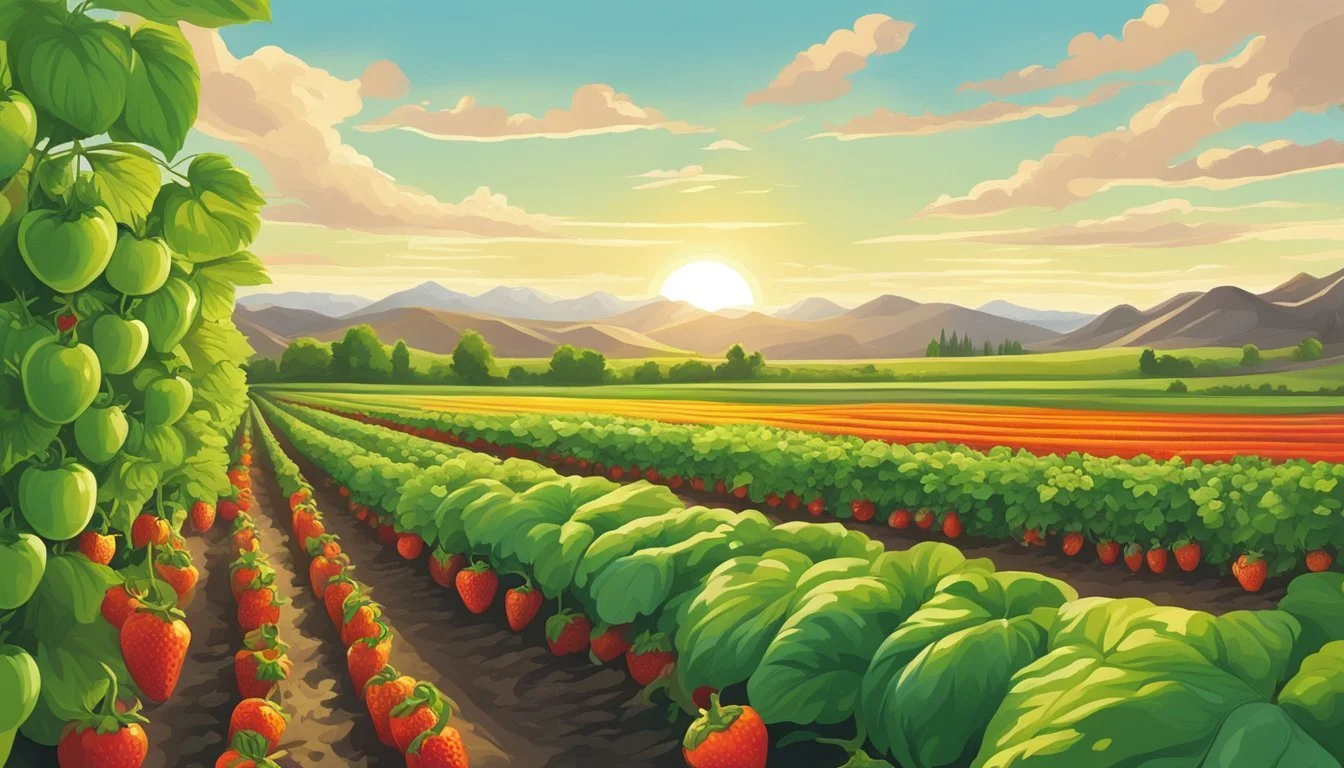Utah Seasonal Fruit & Vegetables in May
Your Fresh Guide
This Article is Part of our Utah Seasonal Fruit & Veg Calendar
As spring blossoms in Utah, so does the variety of fresh produce available to consumers. May marks a transitional period in the agricultural calendar, bridging the gap between the cool, late spring offerings and the onset of summer's bounty. Seasonal eating is embraced in Utah, where the climate and soil conditions are conducive to a diverse range of fruits and vegetables, offering flavors that are as fresh as the mountain air.
Local farmers' markets begin to boast an increasing variety of produce during the month of May. Greens like arugula and spinach (What wine goes well with spinach?) continue to thrive, while root vegetables such as beets (how long do beets last?) start to make their appearance. Asparagus (how long does asparagus last?), a springtime favorite, reaches its peak, offering a tender and flavorful addition to the table. Meanwhile, the orchards hint at the coming abundance of summer fruits, as the last of the winter-stored apples give way to the promise of cherries (how long do cherries last?) and apricots in the weeks to follow.
Basics of Utah's Growing Seasons
Utah's diverse climate dictates its growing seasons, with variations depending on altitude and location within the state. The growing season typically ranges from late April to October, although this can extend or shorten based on the year's specific weather patterns. Spring and fall are crucial transition periods, often with unpredictable temperatures that can impact planting and harvesting times.
Spring in Utah sees the tail end of cold temperatures, and as it warms, the soil becomes suitable for planting. The risk of frost lingers, making it essential for growers to be mindful when starting their crops.
Summer offers the peak of Utah's growing season, with long, warm days that are advantageous for most fruits and vegetables. Harvest typically begins in summer and can include a range of produce from berries to green vegetables.
Come fall, the cooler temperatures allow for a second wave of planting for some crops. Harvesting continues, but preparations for the end of the growing season commence as the first frosts can appear as early as October.
Winter is generally a dormant time for Utah gardens, with the cold, often snowy weather inhibiting growth. However, some hearty vegetables can survive mild winters, and greenhouse cultivation provides options for year-round growth.
Season Characteristics Planting & Harvest Spring Warming soil, late frosts Initial planting phase Summer Long, warm days Peak of harvest Fall Cooler temperatures, early frosts End of season planting & harvest Winter Dormant period for most outdoor growth Hearty vegetables, greenhouse growing
By understanding these basics and closely monitoring local conditions, growers in Utah can optimize their efforts for a successful and bountiful growing season.
Key Vegetables and Their Harvest Times
In May, Utah's vegetable scene begins to flourish, offering an array of fresh produce that varies from leafy greens to hardy root vegetables and the first of the fruit vegetables.
Leafy Greens
Lettuce: Peaks in May, with varieties like Romaine and Butterhead readily available.
Spinach: Harvested in the cool, early season of May provides tender leaves for salads.
Kale: This hardy leafy green thrives, and May is a prime month for young, tender leaves.
Arugula: (how long does arugula last?) Appreciated for its peppery flavor, it’s typically ready come May.
Root Vegetables
Carrots: Begin to be harvested in late May, making for sweet, crunchy additions to meals.
Radishes: Quick to mature, they're often ready for harvest in early May.
Beets: Their season starts in May, offering earthy flavors to dishes.
Turnips: Can be pulled from the ground in May, offering both roots and greens for cooking.
Cruciferous Vegetables
Broccoli: Starts to become available in late May, favored for its health benefits.
Cauliflower: Can also be found beginning late May, known for its versatility.
Cabbage: May marks the beginning of cabbage season, presenting fresh heads for various cuisines.
Brussels Sprouts: Though typically a fall crop, some early varieties may be available.
Legumes and More
Peas: Garden, sugar snap, and snow peas all make their appearance in May.
Beans: While green beans are summer favorites, some early varieties might be sown in May.
Other Vegetables
Asparagus: Hits its stride in May, with spears being at their most tender.
Onions: Spring varieties are often ready for harvest during this month.
Herbs
Basil: (how long does basil last?) Starts to become available in late May, perfect for fresh pesto.
Parsley: Often ready in May, adds freshness to dishes.
Mint: Comes into season, bringing its cool flavor to the fore.
Chives: Their mild oniony flavor can be enjoyed as they typically mature in May.
Fruit Vegetables
Tomatoes: Early varieties may start to become available in greenhouses.
Peppers: Like tomatoes, may be found from protected growing environments.
Eggplant: Starts in late spring, so early harvests might begin in greenhouses during May.
Fruit Harvest Calendar
In May, Utah's fruit harvest begins to pick up, particularly with the onset of berry season and a few early varieties of stone fruits making their appearance. Melons, however, are not typically harvested this early in the season.
Berries
May marks the start of the berry picking for certain early varieties. Typically, strawberries are among the first to be harvested.
Strawberries: Begin in late May
Raspberries: Not yet in season
Stone Fruits
Stone fruits start to come into season by late May, offering a preview of the summer bounty to come.
Cherries: Early varieties may start in late May
Apricots: Early varieties possibly begin in late May
Peaches: Not yet in season
Plums: Not yet in season
Nectarines: Not yet in season
Melons
Melon harvest in Utah typically occurs later in the year, so in May, these fruits are still growing and not ready for harvest.
Watermelons: Not in season
Cantaloupes(how long does cantaloupe last?): Not in season
Honeydew: Not in season
During May in Utah, the focus is on the early harvest of strawberries and the last of the cherries, with the promise of stone fruits beginning to show. Melons require more time and warmer temperatures and are not part of this month's harvest.
Planning and Planting
May is a pivotal month for gardeners and farmers in Utah, marking a transition from spring to the warm beginnings of summer. This period is crucial for sowing seeds and establishing transplants to ensure a thriving garden.
When planning what to plant, individuals should consider the average last frost date and current soil temperatures. It is generally safe to plant frost-sensitive varieties due to the diminished risk of a late freeze. Gardeners should prepare their soil, ensuring it is loose, well-drained, and rich in organic matter before planting.
Seeding Directly: Some crops are best sown directly into the garden as they do not transplant well. These include:
Carrots
Radishes
Beans
Transplanting: For crops started indoors or purchased as transplants, careful handling is essential to avoid shock. These plants include:
Tomatoes
Peppers
Squash
Method: Use a drip irrigation system or mulch to retain moisture and suppress weeds. Thin out seedlings to prevent overcrowding.
Garden Planning: Rotate crops from the previous year to avoid soil depletion and reduce the risk of disease. Keep records to track progress and make informed adjustments for future planting.
Farmers should scale their operations according to market demand, climate conditions, and labor availability. Utilizing greenhouses or hoop houses can extend the growing season for certain crops, often resulting in an early harvest and extended sales period. Both gardeners and farmers ought to remain vigilant for pests and diseases, employing preventive measures as needed.
By meticulously planning and applying these planting strategies, Utah's gardeners and farmers can optimize their yields for the season.
Utah's Farmers Markets
Utah's Farmers Markets are vibrant gathering places where locals can access a wide array of fresh produce during their respective seasons. Farmers from across the state, including cities like Ogden and smaller urban centers like Price, converge at these markets to offer their freshest fruits, vegetables, and artisanal products.
May in Utah marks the beginning of the season for many farmers markets, and visitors can expect to see a variety of spring produce:
Asparagus
Radishes
Greens (such as lettuce and spinach)
These markets also provide a platform for farmers to sell directly to consumers, ensuring the produce is not only fresh but also that the economic benefits remain within the local community.
Notable Farmers Markets in May:
Ogden Farmers Market: Known for its community-centric atmosphere and a wide variety of local goods.
Price Farmers Market: Offers an intimate setting to purchase produce and engage with local growers.
The following table highlights typical operational times for these markets, although it's always recommended to check for updates as schedules can change:
Market Location Operating Days Operating Times Ogden Saturdays 8 am - 1 pm Price Saturdays 9 am - Noon
These markets also serve as hubs for educational and social activities, with some providing cooking demonstrations, food preservation workshops, and opportunities to learn more directly from the farmers about sustainable agriculture practices. The visiting public can expect a friendly and open atmosphere where they can ask questions and gain knowledge about the produce they are purchasing.
Gardening Tips for Success
Region: In Utah, the varied elevation and climate across the state can affect when and what gardeners plant. They should be mindful of their specific location and the corresponding microclimate influences on their gardens.
Hardiness Zone: Most of Utah falls within USDA hardiness zones 4-8. Gardeners should select fruit and vegetable varieties that are well-suited to these zones to ensure a successful fall harvest.
Timing: Planting warm-season vegetables and annual flowers is best done after the last frost, which can vary throughout Utah. Gardeners should monitor local frost dates and plant accordingly.
Thinning Seedlings: When seedlings become overcrowded, they should be thinned out using scissors. This avoids root disturbance and ensures stronger growth.
Frost Protection: Protect fruit blossoms and tender plants from late freeze temperatures. Gardeners can use frost cloths or plant strategically in sheltered locations.
Root Health: Tomatoes benefit from being planted deeper to allow more roots to form along the stem, which leads to a more vigorous plant. This strategy often enhances the plant's ability to resist disease and thrive.
Rotation: To reduce disease buildup, rotate vegetable families each season. This disrupts disease life cycles and can lead to a more bountiful harvest.
Plant Selection:
Fruits: Consider cold-hardy varieties that can withstand spring temperature fluctuations.
Vegetables: Choose species with shorter growing periods to ensure they ripen before the first fall frost.
Soil Preparation: Enrich the soil with compost or well-aged manure before planting to promote healthy plant growth and improve water retention.
By carefully selecting plant varieties, properly timing planting, providing protection from late frosts, and ensuring good soil health and disease management through rotation, gardeners in Utah can maximize their chances of a successful harvest.
Understanding Utah's Microclimates
Utah's diverse geography fosters multiple microclimates that significantly influence agricultural productivity, including the growth pattern of fruits and vegetables.
Mountainous Regions and Frost: The state's varied elevation means that certain high-altitude areas, particularly bench and foothill regions, are susceptible to spring frosts. However, they often escape the coldest temperatures due to cold air drainage, which can be advantageous for crops that are susceptible to frost, like spring onions.
Spring Onions and Green Onions in Microclimates: Microclimates with milder temperatures can extend the planting and harvesting season. Growers can benefit from understanding their specific regional microclimates to optimize the growth of crops like spring onions and green onions, which prefer cooler weather but are vulnerable to frost.
Notable Regions:
The Wasatch Front: Known for its urban microclimates that can be warmer due to heat retention from buildings and pavement.
Cache Valley: An example of a colder mountain valley that can have shorter growing seasons.
Region Spring Planting Known for Wasatch Front Earlier Extended growing seasons Cache Valley Later Shorter growing seasons
Fruit and vegetable growers must pay close attention to these microclimates in order to make informed decisions about planting schedules and protection against late frosts. They utilize this detailed climate understanding to maximize the yield and quality of their produce throughout the changing seasons.
Seasonal Recipes and Uses
May in Utah heralds a bounty of fresh fruits and vegetables, offering a variety of options for healthful and flavorful recipes. Residents can delight in the freshness of peas, revel in the succulence of raspberries, and savor the sweetness of strawberries, all ripe for the picking.
Salads are an ideal starting point for exploring seasonal produce. One might consider combining crisp lettuce with spinach and arugula, tossing in radishes for a peppery crunch, and garnishing with pea tendrils for a tender bite. Strawberry spinach salads, dressed with a balsamic vinaigrette, make for a refreshing and visually appealing dish.
For a heartier meal, beets can be roasted to enhance their natural sugars and paired with goat cheese for a savory contrast. They can also be shredded raw into salads for an earthy, crunchy addition.
Vegetable Preparation Pairing Peas Steamed Mint Radishes Sliced raw Butter Beets Roasted Citrus
Desserts can see an infusion of the seasonal with raspberries and strawberries taking center stage. Utilize these berries in tarts, mousses, or a simple yet elegant macerated berry bowl enhanced with a touch of honey and a sprig of mint.
Herbs like basil thrive during this time and can be incorporated across dishes. Fresh basil can elevate a simple pizza with fresh tomatoes, or be blended into pesto for a versatile sauce that complements both pastas and bruschetta.
Cooking during May should capitalize on the peak freshness of ingredients available, with simple preparations that let the natural flavors of Utah's fruits and vegetables shine.
Conclusion
In Utah, the month of May marks a period of fresh beginnings in the local produce landscape. Gardeners and farmers anticipate the arrival of tender crops, which promise a bounty of fresh flavors to consumers. Seasonal eating is encouraged, as it supports local agriculture and tends to offer more nutritious and flavorful options.
During this time, various fruits and vegetables begin to reach their peak. Consumers can expect the following:
Vegetables:
Asparagus: A spring favorite, perfect for grilling or steaming.
Lettuce: Crisp and fresh, ideal for salads.
Radishes: With a peppery kick, these are a great addition to spring dishes.
Spinach: Versatile and packed with nutrients.
Turnips: Root vegetables that can be roasted or mashed.
Fruits:
Strawberries: Sweet and juicy, excellent for desserts or as a snack.
It is worth noting that the exact timing of produce availability may vary based on specific climate conditions and farming practices. Patrons are encouraged to visit local farmers' markets to find the freshest options and support the local economy. By choosing locally sourced produce, individuals not only enjoy the health benefits but also contribute to a sustainable food system within their community. This practice ensures a continued variety of fresh foods for seasons to come.









